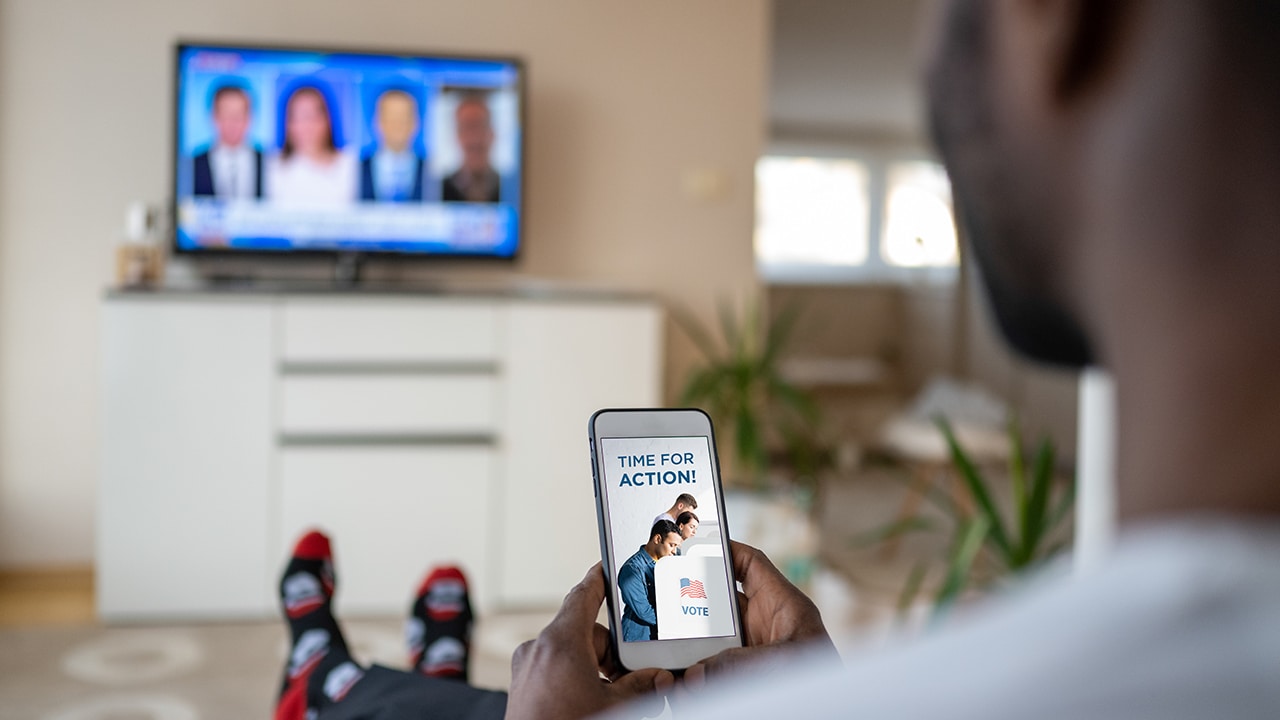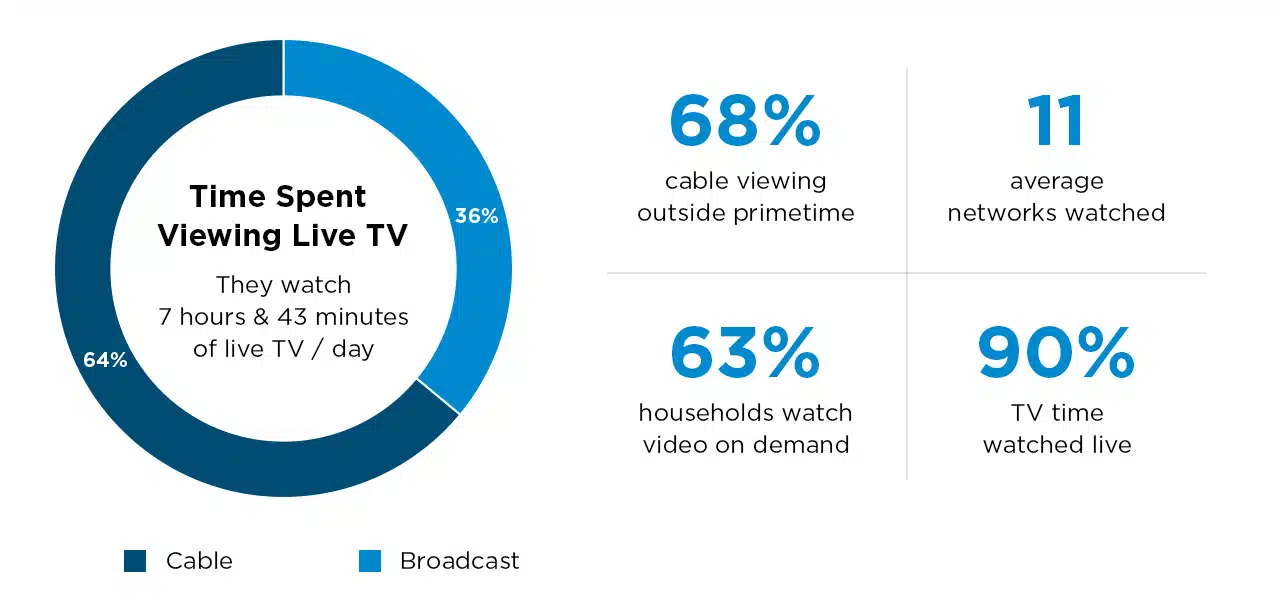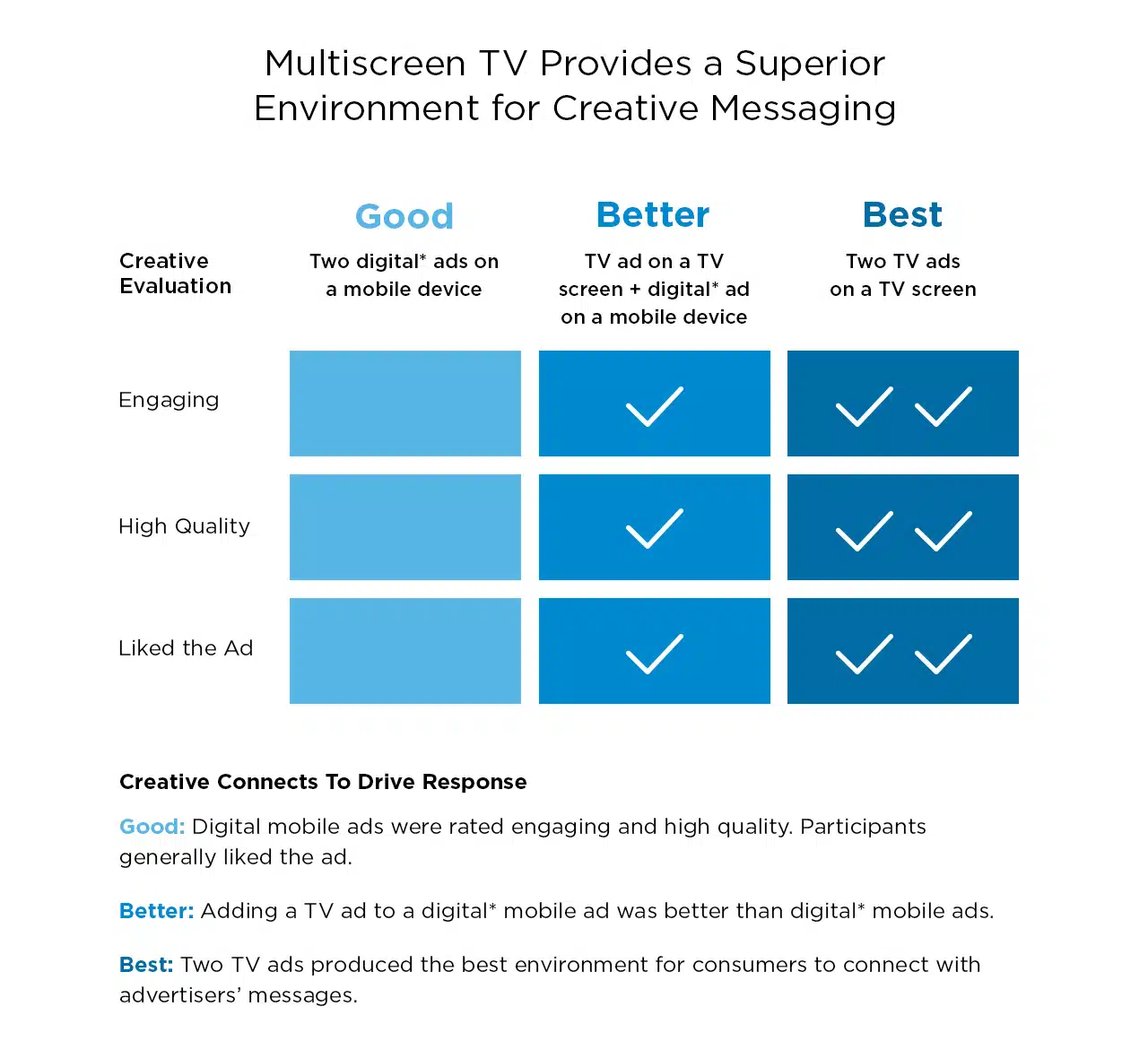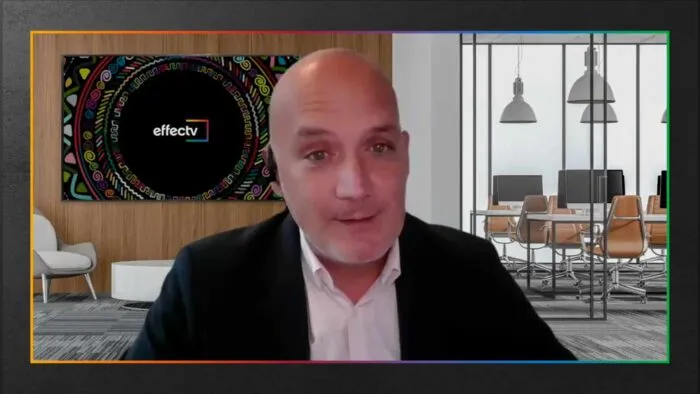Digital advertising has gained significant prominence for advertisers in recent years, however, contrary to the misleading notion that “cable is dead,” traditional TV continues to hold substantial influence for political campaigns. Cable TV has the ability to reach a large pool of potential voters and helps shape voter perception—making it an essential component of any campaign’s advertising strategy.
Year over year, there’s been a 4% increase in overall audience viewing when comparing April 2023 to April 2022.1 While some viewing occurs in subscription-based environments that may be ad-free, a significant portion—nearly two-thirds—takes place in ad-supported environments: cable, broadcast, and free ad-supported streaming platforms (FASTs). These ad-supported environments present a remarkable opportunity for political advertisers to effectively communicate their message to engaged viewers.
Together, Traditional TV and Streaming Reach Voters and Impact Elections
Traditional TV continues to play a pivotal role in campaign strategy as the medium effectively reaches and speaks to audiences at unmatched scale. In an analysis of 28 statewide senate and gubernatorial races during the 2020 election cycle, Comcast Advertising found that winning campaigns reached 35% more households and achieved 118% more household impressions compared to their losing counterparts.2 Their successes can be attributed, in part, to their 35% higher spending on traditional TV advertising, which may have increased their chances of influencing voter opinions.2 Wider reach remains a key factor in election outcomes, highlighting the enduring impact of this advertising approach.
In the 2022 general election, Comcast’s aggregated first-party viewership data revealed live TV viewership is strong among active and engaged voters. Data analysis found the majority of voters aged 35+ watch 77% more cable than broadcast channels, with 90% of their cable TV time dedicated to live programming.3 This emphasizes the appeal of real-time television among this audience. Moreover, 68% of the time that this demographic engages with cable is outside primetime, indicating that viewers are not just tuning in during peak hours but are engaged throughout the entire day.3 They also watch an average of 11 networks, highlighting the diverse programming options available on cable.
Although a candidate’s digital outreach will play a role in reaching and influencing voters, research suggests that candidates can’t win with digital efforts alone. Multiscreen TV campaigns including both traditional TV and streaming are an effective way to reach engaged voters.
Why Does TV Have a Strong Impact on Voters? Because TV Makes Memories.
TV advertising has a unique ability to build brand awareness and shape public opinion. This makes it an essential platform for political candidates to utilize during election season. A Comcast Advertising study uncovered how different types of ad exposure impacts memory – an important component to measure when name recognition is critical in motivating voters. The study tested a digital environment consisting of either short-form YouTube clips or feed-based Facebook advertising (both on a mobile device), with and against a TV environment, consisting of either traditional TV or connected TV (CTV) programming on a large screen.
The study found that ads in long-form content on TV, viewed in a lean-back environment, had a greater unaided recall (how well a viewer remembers an advertisement without any clues or visuals) and purchase intent than the same ads shown in short-form on small-screen digital mobile environments such as Facebook or YouTube. Interestingly, memories were even stronger when a TV ad preceded a digital ad for the same brand, further proving the effectiveness of adding TV (traditional or streaming) to any digital* campaign strategy for maximum impact.4 The study also revealed that two ads shown on a TV screen (traditional or streaming) were more effective than two digital* ads shown on a mobile device; they elicited 1.4X more visual attention, lead to 2.2X greater unaided recall, and spurred 1.6X more recognition.4
TV has a high level of credibility and trust among viewers, making it a powerful force to shape voter opinions. Advertising on the big screen allows candidates to deliver a compelling and emotionally resonant message through sight, sound, and motion, creating a memorable impact on viewers.4
TV advertising enables you to reach a wide audience of potential voters (which matters when it comes to potentially influencing election results). Data suggests the most effective way to imprint the strongest memories for potential voters is through premium long-form TV advertising, both traditional and streaming, on the big screen.
Reach Voters with the Power of Multiscreen TV Advertising
Comcast aggregated viewership data during the 2022 primaries proved that combining TV and streaming was proven to lead to better outcomes.5 While TV continues to be a crucial foundation of media plans and is the main force in driving household reach, streaming is becoming an increasingly important element in political advertising. Streaming allows for incremental audiences to be reached, particularly households of frequent voters that TV may not reach.
Traditional TV advertising remains a powerful platform for political candidates to reach large audiences, deliver targeted messages, and shape voter perception. The ways consumers access video content continue to diversify yet nearly 50% of households still subscribe to a cable or satellite service. A third of households are accessing content exclusively through broadband internet which they can use to stream ad-supported content.6
With Comcast Advertising’s unique data-driven, audience targeting approach, multiscreen TV advertising can be a cost-effective solution as you can ensure your message reaches only the voters that matter most. As campaigns gear up for upcoming elections, it’s essential to consider the continued relevance of TV advertising and utilize its ability to achieve campaign objectives.
Comcast Advertising specializes in connecting candidates to voters across every screen, contact a Political advertising expert today for more information on how we can work together, and visit our Political page for more information and resources.
Sources:
*Digital comprises of Facebook and Youtube on a mobile device.
1. Nielsen Npower, Ratings Analysis Time Period Report – Streaming data from Streaming Meter Panel Live, Linear Data from National Sample, Live+7, Total Day, P2+, Total US, April 2023 vs. April 2022. Total viewing derived from Total HUT/PUT. Ad-supported viewing sources include Ad-Supported Cable, Broadcast, Independents, Total Network Streaming (Owned and operated apps from linear TV networks) & Total AVOD. MPVD/vMVPD streaming credited to linear viewing sources.
2. Comcast Internal Analysis of 28 statewide senate and gubernatorial races (June 2020-November 3, 2020).
3. Comcast Aggregated Viewership Data, Q4 2022 All Comcast Advertising DMAs, Target: A35 Frequent General Election Voters+.
4. Media Science, Comcast Advertising Study, March 2022, n=188. Analysis compares two TV (traditional or streaming) ads to two digital ads.
5. Comcast Aggregated Viewership Data combined with Ad Exposure Data from TV and/or Streaming campaigns in the Political category (9/6/22 – 11/7/22). Target: Frequent General Election Voters. Target based on Experian & L2.
6. Nielsen Npower, National Panel, US HHs, May 2023.







